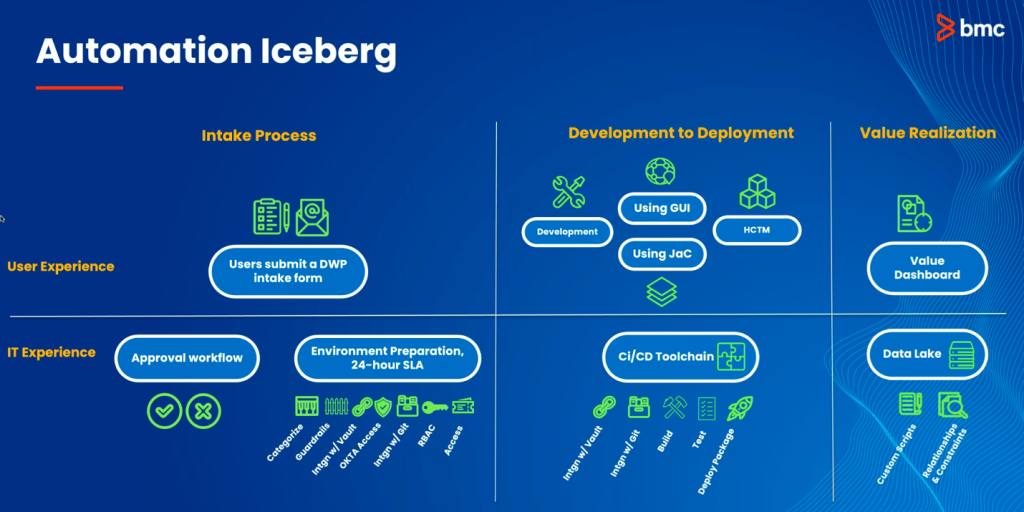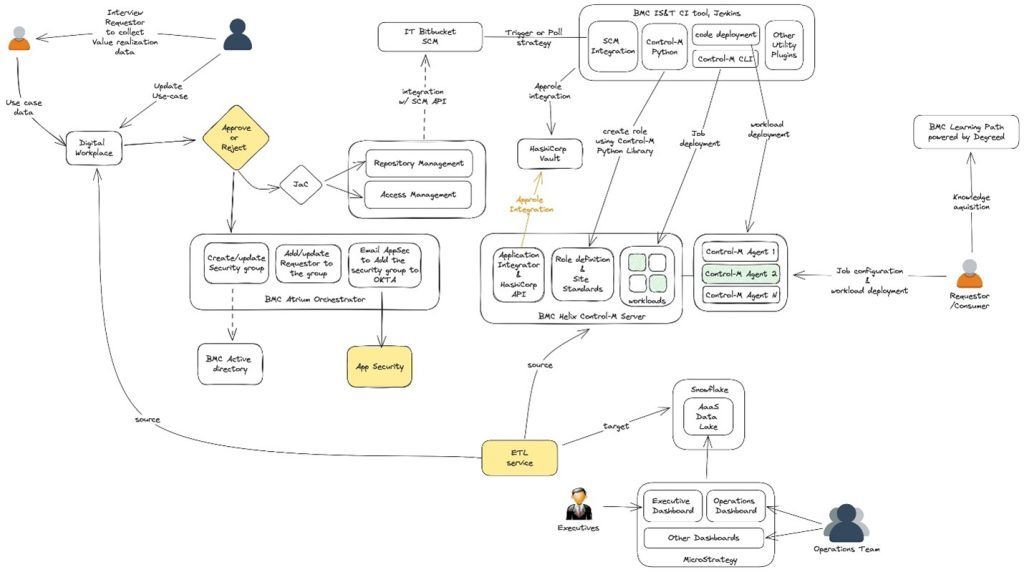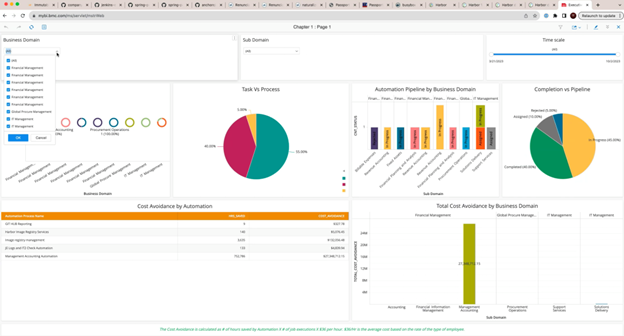Many of BMC’s day-to-day operations run on our own solutions, which keeps us operating efficiently and gives us essential insights into our customers’ challenges and how we can improve our offerings. We call this approach BMC on BMC, and Control-M Saas is a big part of it. As we’ve highlighted in previous blogs, Control-M orchestrates the thousands of workflows that keep BMC running daily and has produced many benefits for various business units, including finance, the enterprise data warehouse team, customer support, sales operations, marketing and more. Some of their reported results include $27 million in recurring cost avoidance savings through application and data workflow orchestration; 40–50 days saved annually in sales operations; automated generation of key executive reports, which eliminated the need for one manager to do it weekly; a significantly streamlined quarterly close process; and more.
The automation and operational dashboards that Control-M provides have been great for our business. As word of these successes spread, more business users came forward with their ideas for new use cases. In addition to using Control-M on our own projects, another thing BMC had in common with many of our customers is that our workflow development was centralized and the Information Systems and Technology (IS&T) department was the gatekeeper. It became very challenging for our IS&T operations team to balance keeping our systems running and meeting the demand for new services.
This situation is common and is a leading driver for the citizen development movement, where companies are giving their non-IS&T business users the autonomy to create their services. Flipping the development model from centralized to decentralized can break development logjams, but it carries risks. Workflows today are more complex and have more dependencies than ever, making security and governance harder to maintain. Citizen developers can’t be expected to account for all the variables that could cause new services they envision to cause other enterprise workflows to crash or open other vulnerabilities.
We in IS&T operations understood these risks. We also understood that we needed to embrace citizen development to keep the company agile. That understanding formed the foundation of our automation-as-a-service (AaaS) program. With Control-M Saas at the center, democratizing data and giving users the tools they needed to orchestrate workflows and business services became easy. It also helped us mitigate new risks and handle governance blind spots.
Before implementing decentralized workflow development and orchestration, our business users dedicated significant time submitting requests, while IS&T invested substantial effort in follow-up and development. However, with the introduction of AaaS, the landscape transformed. Business users are now efficiently deploying more services into production, automation processes have become streamlined, and IS&T resources have been liberated to concentrate on innovation. Let’s delve into a comparison of the processes before and after this transformation.
Before AaaS
It typically took one to three days for a business user to complete a request for a new service. Because requests involve using data from multiple systems, the requesting business user needed to find and contact numerous system administrators to request permission to access various applications and their data, which meant opening multiple tickets to support a single job request.
The IS&T operations team found themselves inundated with an escalating volume of automation requests from different departments across the business. Each request required careful evaluation, leading to a decision of approval or rejection, followed by the development of workflows for those that were accepted. Upon acceptance, our team undertook the entire development process, encompassing integration creation, extensive testing, conflict resolution with existing workflows, identification of security vulnerabilities, and the subsequent deployment of services into production. Development timelines fluctuated significantly depending on the complexity of each task. Leveraging Control-M proved instrumental, as it automated numerous development and execution tasks while offering a plethora of pre-built integrations.
Introducing AaaS via Control-M Saas has revolutionized our workflow request and development procedures. By leveraging Control-M Saas, we’ve significantly streamlined the formerly time-consuming, labor-intensive, and costly processes associated with requesting and developing workflows. We’ve automated the entire workflow lifecycle, from initial request submission (ticketing) through follow-ups for missing information to decision-making regarding approval or rejection of new business services. Moreover, we’ve optimized environment provisioning and provided users whose projects were approved with tailored training via learning paths. What previously took users several days to request services now takes hours. Furthermore, our learning paths actively encourage users to explore and utilize the modern features of Control-M Saas, thus accelerating the automation process even further.
Providing AaaS with Control-M Saas
We’re achieving even greater efficiencies in workflow development, primarily because users are taking the lead, requiring minimal intervention from IS&T for each workflow. Thanks to Control-M Saas, users can access the tools and integrations to construct workflows seamlessly, facilitated by an intuitive interface. Within this framework, business users enjoy remarkable flexibility in designing automation and other workflows that streamline their tasks. Control-M Saas automatically implements guardrails, preventing user-generated workflows from disrupting others. Our framework logically isolates jobs, mitigating interference between them, with much of this functionality operating seamlessly behind the scenes. The solution also ensures data security with the built-in data protection features that safeguard sensitive information.
Most business users have crafted their workflows use a graphical user interface (GUI) and the Jobs-as-Code methodology. They leverage Control-M Saas’s user-friendly interface and extensive library of pre-built integrations. Additionally, we offer users a token for accessing pre-approved code on GitHub. To further support users, we’ve developed a learning path that enables them to explore Control-M Saas’s capabilities.
With this solution, IS&T no longer creates automation and workflows; instead, the business users are responsible. Our task is to provide them with the necessary resources and ensure the smooth operation of the overall system, with Control-M Saas Control-M handling most of the automation processes.

Figure 1. When it comes to automation, a lot of work goes on behind the scenes.
AaaS architecture:
The image above represents the architecture behind AaaS. There are many moving parts, but at a high level, the architecture represents the following process:
- The automated workflows commence once approval is obtained, and the security team has integrated the required group into OKTA. We aim to automate the OKTA process soon as part of our ongoing enhancements.
Through its Automation API, we’ve seamlessly integrated Control-M Saas into our DevOps toolchain, comprising Bitbucket and HashiCorp Vault. This integration facilitates the provisioning of a secure swim lane within Control-M Saas for the citizen developer, aligning with our enterprise standards for building workflows.

Figure 2. Control-M Saas’s Automation API allowed us to create a secure swim lane for citizen developers within our DevOps toolchain.
While self-service and citizen development aim to empower business users, basing the program on Control-M Saas has greatly benefited our IS&T and operations teams. As we’ll elaborate in an upcoming blog post, our use of the application and data workflow orchestration platform has substantially reduced the time burden on the IS&T department by automating a considerable portion of the provisioning and securing environments, enabling business users to create their workflows more efficiently.
One of our notable successes, which we encourage other organizations to adopt as a best practice, involves the creation of a dashboard designed to monitor citizen development projects organization-wide. A recent snapshot from this dashboard is depicted in the image below.
The dashboard calculates the business value derived from developed workflows and automations, providing an ongoing tally. For instance, one business unit has identified $27 million in cost avoidance through its self-developed workflows, with the value increasing with each execution. Such metrics aid us in decision-making regarding request approvals and prioritizations. It is crucial for any initiative to track adoption and usage metrics and to address this need, a dashboard has been established that aggregates data from Control-M Saas and other systems for comprehensive tracking. The screenshot below offers a preview of this dashboard.

Figure 3. Company-wide citizen development metrics dashboard.
“BMC on BMC” isn’t a temporary pilot or project with a predetermined end date or a specific quota of workflows to be developed. It’s an ongoing endeavor that continues to expand its influence across our entire international organization. Over half of our employees have used self-service to access our enterprise data warehouse (EDW), and the impact of user-developed workflows touches every employee in some capacity.
From this experience, we’ve learned some crucial insights:
- Enterprises must decentralize workflow development to effectively manage service requests and drive innovation.
- Decentralization should not entail compromises in workflow security, reliability, or governance.
- Scaling decentralized development and its governance mandates automation as the essential pathway forward.
While Control-M Saas played a crucial enabling role, the collective efforts of many individuals were instrumental in achieving these process improvements. We advise customers aspiring for citizen development to recognize the significance of integrating a robust change management component into their programs. Self-service, citizen development, and advanced automation signify novel approaches to work. Both business users and IS&T professionals must be prepared for these changes. Embracing structured change management is one of our most valuable lessons learned.
While we’ve made significant strides and achieved numerous milestones since our inception, for those deeply engaged, we know that we’ve merely begun to tap into the potential of automation and self-service at BMC. We view it as a continuous journey and aspire to democratize self-service workflow automation for all. In my upcoming blog posts, I’ll delve into the crucial architecture and process of our approach to achieving this vision.
To learn more about Control-M Saas, click here.
These postings are my own and do not necessarily represent BMC's position, strategies, or opinion.
See an error or have a suggestion? Please let us know by emailing blogs@bmc.com.






